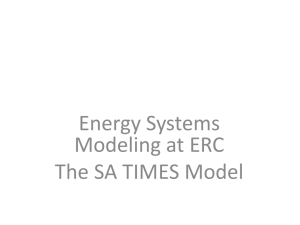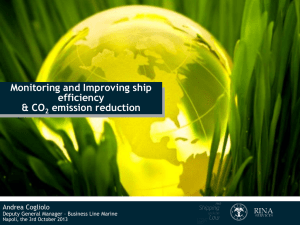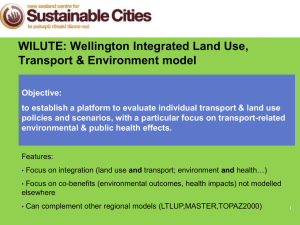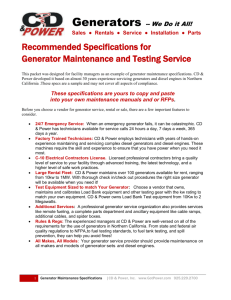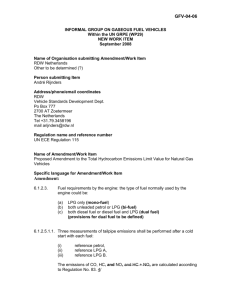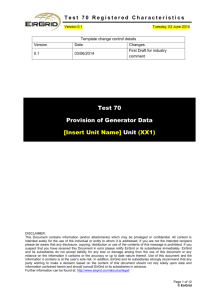Off-Grid Power Markets
advertisement
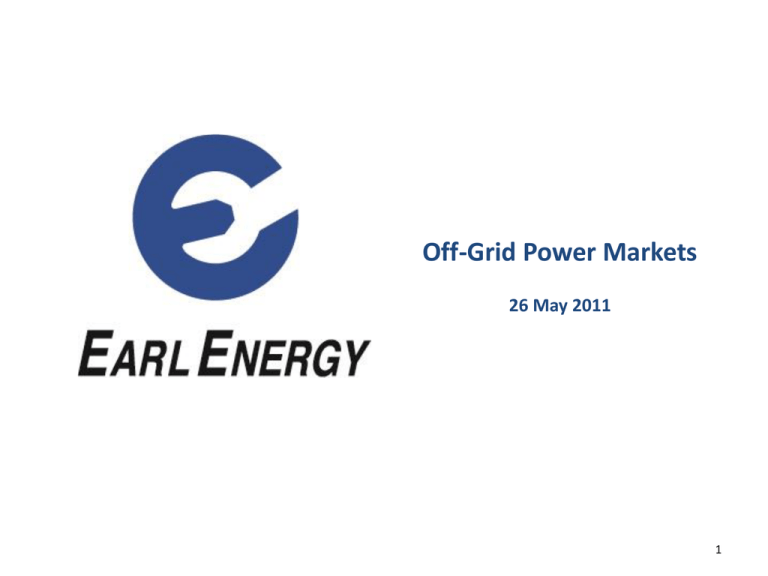
Off-Grid Power Markets 26 May 2011 1 Off-Grid Markets • The off-grid market consists of some of the largest industrial enterprises on the planet, operating in remote and often extreme environments High fuel delivery costs – battlefield, remote locations, at sea Emissions restrictions/incentives – European markets tax carbon emissions, in-port vessels, harbor dredging High maintenance costs – dangerous, harsh or remote locations, at sea, highly technical equipment, mission-oriented power systems Silent and low vibration power – military operational security, luxury yachts, highly instrumented equipment RELIABILIT Y High generator utilization rates – where gensets provide prime power, where engineers factor in excess capacity as a rule Clean, high quality power – sensitive instrumentation RELIABILITY Mission-critical power – uninterruptible power supplies RELIABILITY 2 Generator Dependency and Inefficiency Fuel Consumption in Marine Diesels The area under this curve quantifies generator inefficiency 200% 190% Most operators think they operate at 50-80% load 180% Fuel Consumption (% of Optimal) • Electrical generators in off-grid power systems are highly inefficient, resulting in exponentially higher • Fuel consumption • Emissions • Maintenance costs • Physical depreciation of the generator • In off-grid markets, inefficiency is expensive and customers pay a premium for reliable power • Fuel logistics • Maintenance • Equipment replacement • Emissions mitigation 170% Most actually operate at 10-25% load, where energy costs are 20-50% higher 160% 150% 140% 130% 120% 110% 100% 01 56 11 10 16 15 21 20 26 25 3031 3536 4041 4546 50 Load Factor (%) Example - John Deere 60kW generator Annual Generator Power Output (kWh) Cost of Power at Optimal Power Factor Annual Cost of Power at Optimal Power Factor $ $ 86,085 0.30 25,600 Observed Cost per kWh (incl. fuel & maint.) Observed Annual Cost of Power $ $ 0.71 60,988 Annual Cost of Generator Inefficiency $ 35,388 Example - 60kW Tactical Quiet Generator (TQG) at $10 FBCF Annual Cost of Generator Inefficiency $ 71,743 • • • • • • • Market Size 3,697 tank barges (U.S) 3,932 tugs (U.S.) 6,890 bulk carriers 4,170 containerships 18,982 general cargo 1,600 drilling rigs 1,083 offshore platforms Approximately 8,600 MW of small generator capacity in Iraq and Afghanistan today Annual Cost of Generator Inefficiency • $129 million • $137 million • $6.1 billion • $12.3 billion • $6.7 billion • $944 million • $638 million • Approximately $3.7 billion 3 Expeditionary Market - Fuel Drivers • The U.S. military has established a price signal called the “Fully-Burdened Cost of Fuel” (FBCF) to stimulate development of alternative energy and energy efficiency systems on the battlefield • The FBCF quantifies the costs associated with transporting and securing fuel in the battlespace Delivery/Security to FOB (35Miles) Convoy Delivery/Security FBCF Fuel ($/gallon)* FBCF Fuel ($/gallon/mile) $9.20 - $11.81 $0.26 - $0.34 Convoy Delivery/Air Security $15.63 - $18.59 $0.44 - $ 0.53 Air Delivery/Security $28.94 - $30.78 $0.82 - $0.88 •Headquarters Marine Corps P&R, PA&E 4 Commercial Maritime Market – Emissions Drivers • Oversized power generation capacities for mission-critical systems and redundancy at sea • 24/365 utilization rates and generally low load profiles, especially while in port • Highly variable cost of generator maintenance depending on location of vessel and urgency of repair • Additionally, because the maritime industry is a heavy polluter, it has become the target of intense environmental regulations from a variety of overlapping local, national and international regulatory bodies, particularly focused on air quality and emissions Representative Regulatory Tightening • IMO MARPOL Annex IV, 2010 North American Emissions Control Area (ECA) • In 2020, emissions from ships operating in the ECA are expected to be reduced annually by 320,000 tons for NOx, 90,000 tons for PM2.5, and 920,000 tons for SOx. The overall cost of the North American ECA is estimated at $3.2 billion in 2020, while its benefits are expected to include preventing as many as 14,000 premature deaths* • California Harbor Craft Rule • Existing California Harbor Craft must repower with new diesel engines per a sliding compliance schedule based on the age of the existing engine and home port • Operators may avoid repowering if they demonstrate that the engine operates <300 hours per year • PA NY NJ Harbor Deepening Project • Requires operators to offset all NOx emissions so that dredging in NOx net-zero Area of the North American ECA* * Designation of North American Emission Control Area to Reduce Emissions from Ships: Regulatory Announcement , EPA-420-F-10-015, March 2010 5 Why Now? • Renewables, energy storage, and large-scale power conversion technology have benefitted from 5+ years of significant government and private investment resulting in lower costs and improved performance, reliability, and safety • In off-grid markets, the costs of hybrid power are now competitive with traditional power systems Increasing Operating Costs Fuel Emissions Environmental Regulations Safety Reliability Maintenance $ Hybrid power is economically compelling today in off-grid markets… … and will improve in the future Decreasing Hybrid Power Costs Renewables Energy Storage Power Electronics Specialized Engineers Time 6 Thank You Josh Prueher Office: 757-606-3214 Mobile: 917-806-1725 jprueher@earlenergy.com www.earlenergy.com 7
